![]()
![]()
![]()
Use LEFT and RIGHT arrow keys to navigate between flashcards;
Use UP and DOWN arrow keys to flip the card;
H to show hint;
A reads text to speech;
22 Cards in this Set
- Front
- Back
- 3rd side (hint)
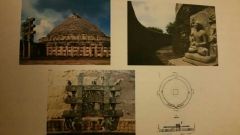
|
Great Stupa at Sanchi 300 B.C.E -100 C.E Madhya Pradesh, India - Buddhist; Maurya, late Sunga dynasty Mound shaoe, dressed stone. Sandstone + stone masonry FORM: 50 ft FUNCTION: burial mound or enclosed relics of Buddhist teachers Marks cardinal directions Walk in clockwise direction = circumambulation CONTENT: Buddha - presence indicated by umbrellas and footprints. Mandala - sacred diagram of the universe with cardinal points marked by torans Circumambulation - in Buddhist worship, walking around the stupa in a clockwise direction CONTEXT: fertility deities (yakshi- sensuous women 4 fertility and vegetation) delineate transition from sacred to secular IMPORTANT TERMS: Yasti - or pole, axis if the universe. At the top of stupa, covered with chatras Chatras - umbrellas; represent Buddha; symbol if honour and respect Harmika - small platform + railing at top. Represents one of Buddhist heavens Torans - gateway in the stone fence around stupa. Located at cardinal points |
|
|
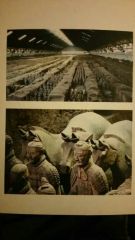
|
Terra cotta warriors from mausoleum of the first Qin emporer of China China - Qin dynasty Painted terracotta 221-209 B.C.E FORM: doaism in individualization of each soldier Originally colorfully painted FUNCTION: protect the emporer in the afterlife CONTENT: representation of Chinese army for the afterlife. CONTEXT: discovered by farmers in 1974. No human bodies |
|
|
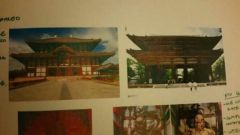
|
Todai-ji Nara, Japan - imperialistic Japan 743 C.E. Wood with ceramic tile roofing, bronze and wood (sculpture), dry lacquer FORM: roof exposed by huge pillars Oldest wooden temple in the world 15 meters tall Use of naturalism and drapery in architecture and sculpture Mimic styles if Korea and China FUNCTION: culmination of imperial architecture To serve as monastic training center/religious practice house To watch over country, protect people, promote peace CONTENT: use Buddhism to change way people view their lives, encourage peace, and implement religion Great Buddha- to symbolize nirvana, true Buddha body and hand gestures of abhaya (do not fear) and varada (welcome. Left hand down, palm facing out), cosmic Buddha associated with the sun Nio guardian figures - ungyo and angyo, ungyo says "ah" meaning life angyo says "um" meaning death (use of juxtaposition here), to protect Buddha CONTEXT: in nara, nara prefecture Japan (once the ancient capital), it's the great eastern temple on the eastern edge of nara |
|
|
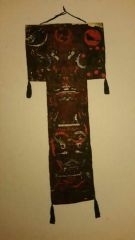
|
Funeral banner of lady Dai (xin zhui) Hunan province , China - han dynasty Painted silk 180 B.C.E. FORM: three distinct regions, yin and yang, 6'8 3/4" x 3' 1/4" FUNCTION: carried in procession to the tomb and then placed over the body to speed up journey to the afterlife CONTENT: top - heaven with crescent moon, middle - earth, lady dai, bottom - nethetworld, symbolic low creatures (fish, turtles) CONTEXT: died in 168. 100+ objects in her tomb. |
|
|
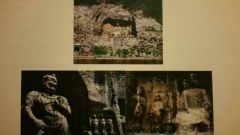
|
Longmen Caves Commissioned by empress wu Luoyang, China - tang dynasty 493 - 1127 C.E. Limestone FORM: arranged as if on an altar in a temple, 44' high FUNCTION: tang artists represented mahayana cosmic Buddha CONTENT: 8000 people worked, 110,000 statues, 60 stupas, 2800 inscriptions on steles CONTEXT: caves along the yi river. Monk attendents and guardians throughout |
|
|
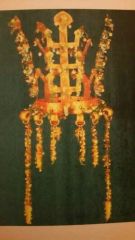
|
Gold and Jade crown Sillia kingdom, Korea - three kingdoms period 5th-6th century C.E. Metalwork, gold + jade FORM: geometrical shapes, abstract nature FUNCTION: likely for ceremonial purposes only CONTENT: shaped like a sacred tree, jade beads = fruits = fertility, antler forms influenced by shamanistic practices in Siberia CONTEXT: worn by emporer, uncovered from royal tomb |
|
|
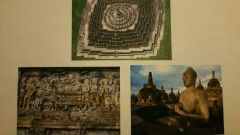
|
Borobudur Temple Central Java, Indonesia - sailendra dynasty 8th-9th century Volcanic stone masonry FORM: Rubble faced with carved volcanic stone. Sailendra = lord of the mountain. A 3 dimensional mandala, pyramid form FUNCTION: place of pilgrimage, meant to be walked around CONTENT: May reflect Buddhist cosmology. Preaching mudra. Cardinal points. CONTEXT: 10 meter stupa at top, 504 lifesize buddhas, 1460 narrative relief sculptures, 1500 stupas. 1mil blocks of carved stone. |
|
|

|
Angkor, the Temple of Angkor Wat, and the City of Angkor Thom, Cambodia Cambodia (Hindu dominant area) - Angkor dynasty 800 - 1400 C.E. Stone masonry, sandstone FORM: sculptural reliefs, rhythmic dance poses, repetition of shapes, influenced from Indian corbelled vaulting FUNCTION: temple built by successive kings. CONTENT: mountain like towers = sacred, mt. Meru center of spiritual universe CONTEXT: capital if medival Cambodia |
|
|
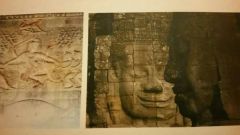
|
Angkor Wat , Churning of the Ocean if Milk (ankgor wat pt 2) patron - Jayavarman VII Cambodia - Angkor dynasty 800 - 1400 Stone masonry, sandstone FORM: longest continual relief in the world. Heavily influenced by his wives. FUNCTION: devoted to Buddhism CONTENT: story if hindu religion. Churning if the ocean of stars to obtain amrita (nectar if immortal god n devils. Creates typhoon. Serpent king defeated by vishnu.) Around mt. Mandara. Mountains are sacred. Red means protection and strength. CONTEXT: around mt. Mandara |
|
|

|
Lakshmana Temple Khajuraho, India - hindu, Chandella dynasty 930 - 950 C.E. FORM: in the center of "embryo" room containing the shrine, very small. Only enough space for priest. Corbelled roofs have a beehive quality. Bands of horizontal moldings on temple sculpture had harmonious integration with the architecture FUNCTION: east/west axis. Receives direct rays from the rising sun CONTENT: figures are sensuous. Erotic poses symbolize regeneration. CONTEXT: placed on high pedestal. Series of shapes that build to become a large tower. Complicated intertwining if similar forms. |
|
|
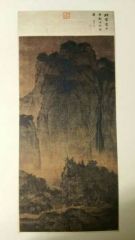
|
Travelers Among Mountains and Streams by Fan Khun (Chinese) China - song period 1000 C.E. Ink and colors on silk FORM: different brush strokes define trees. Long waterfall on right balanced by mountain on keft. Accentuates height if mountain. Constantly shifting viewpoint FUNCTION: view mountains as sacred. Isolated himself from trouble some political times CONTENT: not a pure landscape donkeys loaded with firewood driven by two men. Mountains are sacred. Shanshui Hua - mountain water painting. CONTEXT: artist isolated himself |
|
|
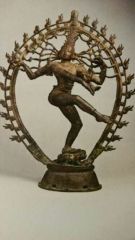
|
Shivaas Lord of Dance (nataraja) Tamil nadu, India - Chola dynasty 11th century C.E. Cast bronze FORM: made for mobility FUNCTION: for worship of shiva. CONTENT: challenged with 3 creatures snake, tiger, and dwarf. Defeats them (hair is snakes, wears a tiger dhuti/skirt and is standing on dwarf.) Damaru - hourglass shaped rum she beats to bring universe into creation. Agni - bowl of fire used to end universe. Abhaya mudra - do not be afraid. Cosmic circle of fire- continuous creation and destruction of universe. Halo represents cosmos. Triple flame is the 3 worlds heaven earth and neyherworld. Has an all seeing third eye. Apasmara dwarf demon of ignorance. CONTEXT: lost wax technique. |
|
|
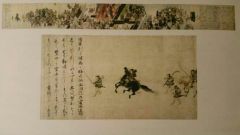
|
Night Attack on the Sanjo Palace Japan - kamakakura period 1250-1300 C.E. FORM: strong diagonal lines/brush strokes are active/show movement. Elevated viewpoint. Depersonalized figures. FUNCTION: military role in japan had interest in warrior code. Reflected in large quantity of related literature and art. CONTENT: imperial palace in flames. Rebels force emporer to board cart to take him captive. Rebels kill all opposed, place their heads on sticks. Lone archer leads escape from burning palace with equestrian japanese commander behind. CONTEXT: painted 100 years after event. |
|
|
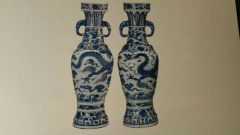
|
The David Vases - named for sir Percival David ; collector of Chinese art China - yuan dynasty May 13, 1351 C.E. White porcelain with cobalt-blue underglaze |
|
|
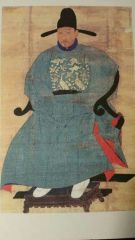
|
Portrait of Sin Sukju Korea 15th century C.E. |
|
|
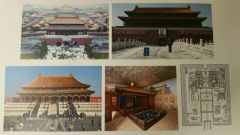
|
Forbidden City Beijing , China - ming dynasty 15th century C.E. - on Stone masonry, marble, brick, wood, ceramic tile |
|
|
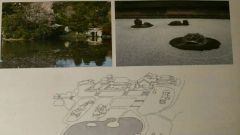
|
Ryonaji (peaceful dragon temple) Kyoto, Japan - muromachi period 1480 C.E. Current design 18th century Rock garden, water garden |
|
|
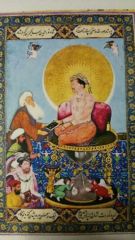
|
Jahangir Preferring a Sufi Shaikh by bicktr India - mughal empire 1620 C.E. Water color, gold, and ink on paper |
Sophie |
|

|
Taj Mahal architect - ustad ahmad lahoro Angra, uttar pradesg, India 1632 - 1653 C.E. Stone masonry and marble Inlay of semiprecious stones ; gardens |
|
|
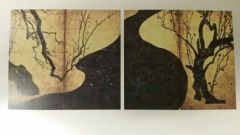
|
White and red plum blossoms by ogata Korin Japan 1710-1716 C.E. Rinpa style Ink, water colors, Gold leaf |
|
|
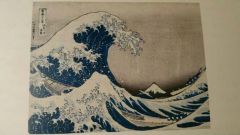
|
Under the wave off Kanagawa (the great wave) by hokusai Japan - edo period Polychrome wood block printing. Ink and color on paper 1830-1833 C.E. |
|
|
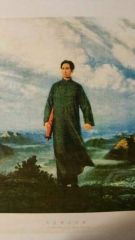
|
Chairman Mao en route to anyuan Based on painting by Liu chunhua, made anonymously China 1969 Color lithography |
|

